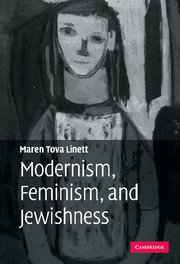Book contents
- Frontmatter
- Contents
- Acknowledgments
- List of abbreviations
- Introduction: imagined Jews and the shape of feminist modernism
- 1 “Strip each statement of its money motive”: Jews and the ideal of disinterested art in Warner, Rhys, and Woolf
- 2 Transformations of supersessionism in Woolf and Richardson
- 3 Adding bathrooms, fomenting revolutions: modernity and Jewishness in Woolf and Warner
- 4 The race must go on: gender, Jewishness, and racial continuity in Barnes and Richardson
- 5 The “No time region”: time, trauma, and Jewishness in Barnes and Rhys
- 6 Metatextual Jewishness: shaping feminist modernism
- Notes
- Works cited
- Index
6 - Metatextual Jewishness: shaping feminist modernism
Published online by Cambridge University Press: 22 September 2009
- Frontmatter
- Contents
- Acknowledgments
- List of abbreviations
- Introduction: imagined Jews and the shape of feminist modernism
- 1 “Strip each statement of its money motive”: Jews and the ideal of disinterested art in Warner, Rhys, and Woolf
- 2 Transformations of supersessionism in Woolf and Richardson
- 3 Adding bathrooms, fomenting revolutions: modernity and Jewishness in Woolf and Warner
- 4 The race must go on: gender, Jewishness, and racial continuity in Barnes and Richardson
- 5 The “No time region”: time, trauma, and Jewishness in Barnes and Rhys
- 6 Metatextual Jewishness: shaping feminist modernism
- Notes
- Works cited
- Index
Summary
In the previous chapters I have focused on the thematic and political functions of Jewishness in key modernist texts. In this concluding chapter I describe additional functions of Jewishness that occur on a metatextual level as the authors enlist their representations of Jews to shape their particular versions of modernism. The Jews in these texts serve as models, foils, and scapegoats for aspects of the authors' artistic approaches. Focusing on these metatextual processes reinforces and sharpens the argument, conveyed throughout this study, that feminist modernism relies on Jewishness for its own self-fashioning.
For Jean Rhys and Sylvia Townsend Warner, the metatextual functions of Jewishness arise more or less directly from their sympathetic thematic enlistment of their Jewish figures. For Djuna Barnes, Nightwood 's somewhat grotesque evocation of Jewishness serves as a ground for an ambivalent metatextual response. For Dorothy Richardson and Virginia Woolf, a metatextual Jewishness that is distinct from their thematic treatment of Jews gathers powerful implications for their modernist projects. This chapter briefly revisits the work of Rhys, Warner, and Barnes before teasing out these implications in Richardson and Woolf.
As I argue in chapter 1, Rhys and Warner use their Jewish characters as models for disinterested art, opposing them to the financial interest that dominates the commercialized world of publishing. These characters are not idealized: Serge arrogantly assumes the Martiniquean woman wants sex and later he fails to show up to bid Sasha farewell; Minna is greedy for attention and unscrupulous in her revolutionary activities.
- Type
- Chapter
- Information
- Modernism, Feminism, and Jewishness , pp. 173 - 189Publisher: Cambridge University PressPrint publication year: 2007



